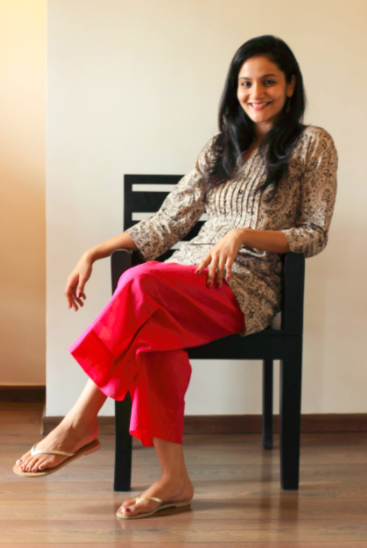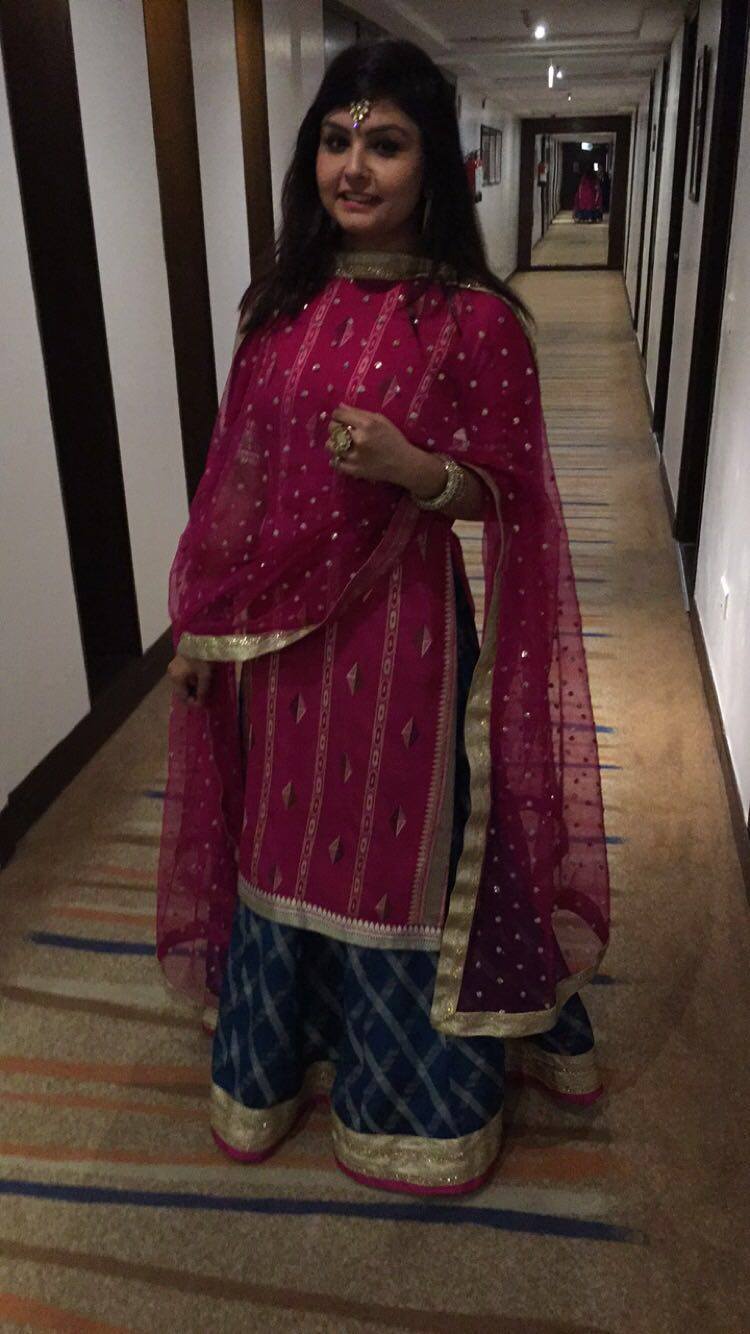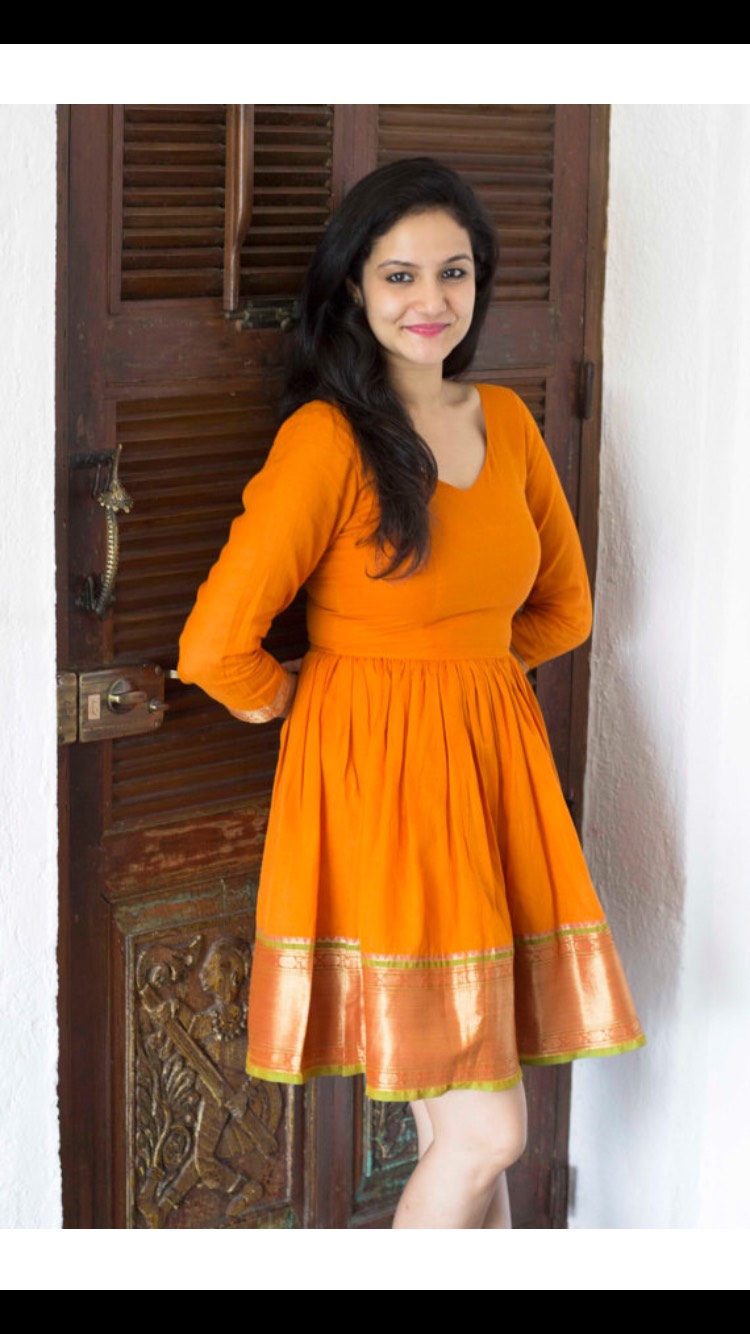
A small town in the Guntur District in Andhra Pradesh on the Guntur-Vijayawada Highway, Mangalgiri home to the Padmashali community whose traditional occupation is weaving and textiles. With about 5000 weavers and over 50 outlets selling the famous weaves of the region – Mangalagiri fabrics, saris, salwar sets and more in silk, cotton and cotton-silk. The weavers work from their homes as well as in indigenous sheds about 5 km away from the town centre in a place called Ratnala Cheruvu. Some of these weavers work for dedicated wholesalers as well as supply to multiple outlets.
The Fabric
Mangalagiri fabric is a pure cotton yarn of largely in 80×80 count with a few in 60×40 count. The count is a measure of the number of threads woven lengthwise which is the warp and breadth-wise which is the weft. What makes this fabric special is that it is woven tightly over pit looms with the weavers sitting with their feet firmly on the ground that gives the fabric its traditional soft texture. Designer Mithi Kalra says, “the uniqueness of the fabric is its durability. Apart from exquisite and bright saree creations, this textile has a global demand too. Initially the fabric is white and then it is dyed and the fine work of Zari is done to complete the same. Since the fabric is extremely fine, the golden thread work done has to be delicate. In fact this fabric can also be mixed with silk and together the combination looks beautiful.” A key distinguishing feature of Mangalagiri saris is its famous traditional zari border also known as Nizam border about two inches thick. The saris have a thick gold border with closely knit patterns that look like small inverted checks. The zari in this border is superimposed by weaving them over the regular weave. The body of the sari is usually plain or has stripes and the simple designs on the pallu are inspired by tribal motifs. Moushumi Mitra, Founder of Perrian Lifestyle says, “its original style of weaving dates back five centuries. Magalagiri saris are woven from combed yarn on pit looms. After weaving, the fabrics are dyed in bright colors and embroidered with golden thread in the zari style. Sometimes weavers will embellish the body of the sari with small zari checks, but Mangalagiri saris are largely plain, with a striped zari embroidered Nizam border on the pallu. The traditional features in the design and weaving of Mangalagiri saris make them closely tied with the culture of the Mangalagiri town. The town houses the Lord Narasimha Temple, where the saris are also used in prayer and devotion. In this way, Mangalagiri fabric and culture are woven together. Combining traditional and modern, Perrian Lifestyle has used Mangalagiri fabric as the basis for a gown rather than a sari, adding a new twist to the five-hundred-year-old cultural staple. As opposed to traditional Nizam embroidery, the neckline of the gown has been embroidered with a reimagined tattoo design, marrying old and new in one item of clothing.”

Materially Speaking
The raw material which is the cotton yarn is sourced locally from Guntur, the Andhra Pradesh State Handloom Weavers Cooperative Society (APCO) and some districts of Tamil Nadu while the zari is sourced from different cities like Ahmedabad, Surat and Bengaluru. There is a set process that needs to be followed for the fabric to be turned into the final product. Firstly, the yarn is cleaned by boiling it with soap and soda which helps remove impurities like seeds, oil, wax as well as its inherent stickiness which makes it ready for the dyeing process. The warp and weft are dyed separately and the yarn is washed dried and starched before being distributed to the weavers. After the yarn is sun dried, it is ready for the weaving process. This yarn is then loaded on to a charka where the yarn becomes the thread forming the warp and weft and is a complex process that needs at least 30 people to work on it before the yarn is ready for weaving. The winding of yarn is done manually on the charka and bobbin to create the warp while the weft is woven on a prin. The dyes used are vat and napthol ones and vegetable dyes are only used if there are specific export orders. Also working with natural dyes is complex and expensive which deters most weavers from using them.
Weaving Techniques
Mangalagiri fabrics are woven using traditional pit looms that enables the weaver to actually exert more force that gives the fabric its tenacity. The pit is dug into the ground and the pedal of the loom is placed in the pit and the weavers sit on the floor and use their hands and legs to operate the loom. The technique is usually passed on from one generation to the other which makes this a special kind of handloom as well. The fabric is only woven on the pit loom and there are no gaps on the weave towards the edges of the fabric which is another unique aspect of the Mangalgiri fabric not seen in other regions. The weavers plant their feet firmly below the ground to apply the right kind of pressure to ensure the tightness of the weave that makes the fabric and zari thick and closely-knit. Again the amount of yarn woven into fabric per loom is quite high which ensures that the fabric is durable and stays intact for longer periods of time. Mangalgiri fabrics are made using the warp and weft method of weaving using the Jaquard weaving process. Unlike machine made fabrics that use power looms, the traditional fabric is always made on the hand looms and is a labour intensive process with each sari taking close to two days to be completed.

Future Perfect
As a fabric that is light and airy, Mangalgiri cottons are an ideal choice for all seasons as they are cool in summer and can be used in winters also. There are a lot of revival measures underway to help give a contemporary and modern twist to the Mangalgiri textiles. While the sarees and dress materials are popular, the young generation has a choice of cotton kurtas, dupattas and stoles with Mangalgiri weaves that are fast becoming popular. Mangalgiri textiles are seeing a revival courtesy the cotton handloom products that are extensively exported as well. This has given a boost to the sector and several weavers are now coming back to the craft. Meghana Joshi, Co-founder, AadikarInk Designs avers, “Mangalgiri is one of the most versatile fabrics for clothing. Until recently it has been used primarily as traditional attire, but now it has caught the attention of fabric lovers and designers alike with its bold colors and striking combinations. Skirts crafted from Mangalgiri are now a staple fusion wear. Slowly but surely, sensibilities are evolving to incorporate palazzos, trousers, culottes and even dresses created using Mangalgiri.” The handloom cottons of Andhra Pradesh offer an extremely wide spectrum of textures and weave which suit a variety of apparel. Mangalgiri and Narayanpeth are few examples which have found a niche in the contemporary apparel space. “In most cases, weavers are being trained to develop and experiment with newer patterns while preserving the traditional techniques of production. These fabrics are then fashioned into fusion wear and apparel with modern sensibilities. This way the age old techniques of weaving are preserved and made relevant at the same time,” adds Joshi. The saris from Mangalgiri are however gaining much popularity primarily due to their superior quality that sets them apart leading to a high demand for them. Weavers and outlets are seeing a good turnover and due to the growing demand have partnered with vendors to sell the saris online as well. In fact these vendors procure over 50 saris a week. With the need to ensure that traditional handloom weaves are kept alive, the fact that Mangalgiri fabrics are patronized not just by designers but also international clients certainly augurs well for the fabric.
This story appeared in the Feb 2018 issue of Apparel magazine here: Mangalagiri